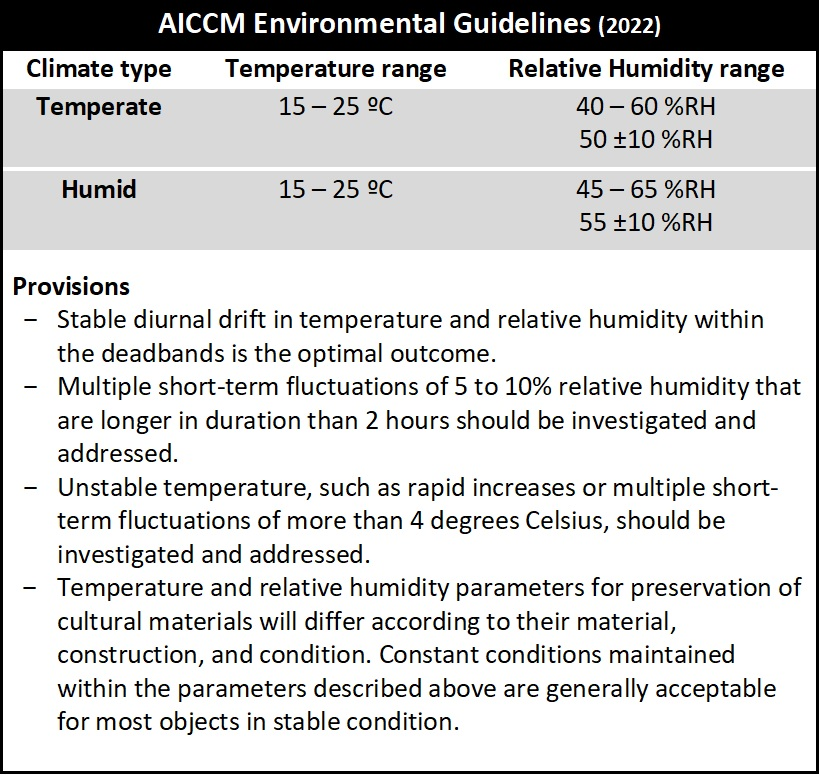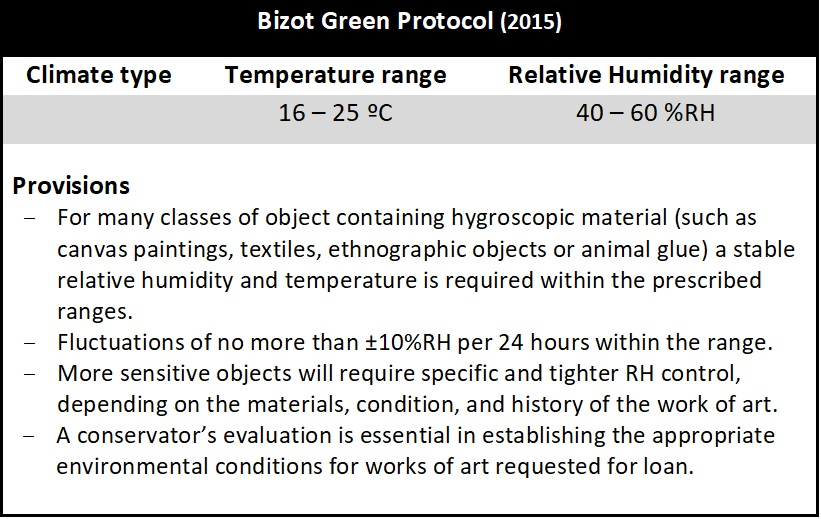In December 2018, AICCM ratified national environmental guidelines for Australian cultural heritage collections (Table 1). In line with the guiding principles of sustainability and resilience; adaptive and proactive practices; and maintaining relevance, the environmental guidelines were reviewed and updated in 2022.
The AICCM Environmental Guidelines for cultural heritage collections provide temperature and relative humidity ranges for humid and temperate climate types and encourage the setting of temperature and relative humidity parameters that respond to a range of factors including local climate conditions.
Four years on from the first publication of the Environmental Guidelines the Australian cultural heritage sector has seen significant advances in climate-conscious and environmentally aware collection management practices and the publication of relevant resources. AICCM publications, including the Sustainable Collections wiki and the Climate Adaptation map resource, can be used to facilitate meaningful climate active discussions and decision-making.
With a deeper understanding within the sector of the links between local climate, energy efficiency and collection care the Sustainable Collections Committee recommended updates to the Environmental Guidelines that move implementation from a conservative controlled mode to a responsive evaluated mode. In this regard minor changes have been made to climate type titles, provisions and application of the guidelines. The temperature and relative humidity ranges have not changed.
Guiding Principles
AICCM’s position on publication of environmental guidelines for the care of cultural heritage collections in Australia is governed by three guiding principles.
Sustainability and resilience
AICCM recognises that sustainable and resilient conservation practice comes from an ability to balance advocacy for and practice in collection care in response to other priorities such as an organisation’s mission, function, programming and resources.
Adaptive and proactive practices
AICCM supports considered, knowledge-based interpretation and use of the published guidelines for the management of the collection environment. AICCM encourages the implementation of environmental controls that address individual needs and circumstances. The published guidelines provide recommendations that are not intended to be prescriptive or inflexible.
Maintaining relevance
AICCM will periodically review the published Environmental Guidelines to ensure that the recommendations remain current and applicable to the national cultural heritage profession, collection care practices, climate change and local climatic conditions.
Assessing risk
Collection
Many stakeholders bring expertise to management of the collection environment including conservators, collection managers, building/facility managers and HVAC engineers and technicians. Preparing for and implementing adjustments to the collection environment requires collaboration and consultation with a range of stakeholders. The building envelope and the type and technical sophistication of the HVAC system effect the successful performance of air conditioning for the collection environment.
Before adopting new strategies and procedures for collection care an organisation should consider the internal and external factors that are likely to influence their objectives. These factors can be described as uncertainty and are often measured as levels of risk. The Australian and New Zealand Standard, Risk Management – Guidelines[1] describes a systematic and logical framework for decision-making and states that,
All activities of an organization involve risk. Organizations manage risk by anticipating, understanding and deciding whether to modify it. Throughout this process they communicate and consult with stakeholders and monitor and review the risk and the controls that are modifying the risk. … Although the practice of risk management has been developed over time and within many sectors to meet diverse needs, the adoption of consistent processes with a comprehensive framework helps ensure that risk is managed effectively, efficiently and coherently across an organization.
Within the Conservation profession risk assessment tools of varying complexity are used to carry out audits to determine specific vulnerabilities and needs of collections. Risk assessments will help to determine the most influential agents of deterioration and the types and frequency of risk created by these agents.
Setting temperature and relative humidity parameters for the collection environment is largely a long-term assessment of risks to collections, whereas risk assessments relating to climate and weather are a mix of immediate and long-term scenarios.
Climate
Global warming has seen rapid changes to climate and an increase in severe weather events. The Intergovernmental Panel on Climate Change (IPCC)[2] confirmed in 2021 that within the Australasian zone,
Above global-average 1.4 ⁰C warming of the Australian landmass has occurred since pre-industrial levels.
Annual temperature changes have emerged above natural variability in all land areas. Heat extremes have increased and cold extremes have decreased.
Relative sea level rose at a rate higher than the global average in recent decades and sandy shorelines have retreated in many locations. Relative sea level is projected to continue to rise in the twenty-first century and beyond, contributing to increased coastal flooding and shoreline retreat.
Climate change and weather extremes require practitioners to be prepared for immediate risk such as heavy rainfall, severe storms, flood, cyclones, heatwaves, extreme bush fires, drought and power outages. Refer to the AICCM Climate Adaptation resource to assess climate change projections for regions across Australia in the short-term 2030 and long-term 2090 and refer to Pagliarino & Meredith[3] in the AICCM Bulletin (41:1) for mid-term 2050.
Biological
Understanding the vulnerability of cultural material to pest infestation and mould outbreak is an essential element of a holistic risk assessment. Insect behaviour and the conditions for mould growth are affected by a warming and changing climate.
Warmer temperatures are associated with accelerated insect life cycles, feeding, breeding, mobility, and changed migration patterns. It is predicted that there will be increases in activity in museum pest that exhibit generalist characteristics, have adapted to urban environments and benefit from human-mediated dispersal. This includes carpet beetles, dry-store beetles, silverfish, clothes and casing moths, and drywood termites.[3]
Mould is a naturally occurring fungus that under specific conditions will grow on some surfaces. Mould becomes problematic when it is found growing on the surface of objects in cultural heritage collections. Damp conditions, high humidity, warm temperatures, differential temperatures, poor air flow, and accumulation of dust and grease on surfaces will contribute to an environment that sustains mould growth.
To reduce the risk of mould outbreaks it is recommended that cultural heritage collections are stored and displayed in clean dry environments with good air circulation. To prevent mould growth relative humidity should be maintained below 70%.[4,5,6,7,8]
Other guidelines
The following illustration (Table 2) provides a simplified comparison of a range of environmental guidelines that are currently in use for the collection environment. This includes Garry Thomson’s[9] recommendations from the seminal publication The Museum Environment, the AICCM Environmental Guidelines, the Heritage Collections Council[6] guidelines, the Bizot Green Protocol[10], and the American Society of Heating, Refrigerating and Air-Conditioning Engineers[5] classification system for museums, galleries, archives and libraries.
AICCM continues to endorse the Heritage Collections Council (HCC) Guidelines for Environmental Control in Cultural Institutions (Table 3). The HCC guidelines are particularly useful for collections housed in passive or non-climate controlled buildings. AICCM also recognises the Bizot Green Protocol (Table 4) as an international guideline that may be applicable and agreeable to individual organisations that are lending cultural objects across differing geographical locations, countries or global hemispheres.
In the era of rapid climate change it is imperative that the conservation profession takes a leading role in reviewing collection care and collection access practices to improve energy efficiency, reduce greenhouse gas emissions and move towards sustainable collection practices.
References
- AS NZS ISO 31000 (2018) Risk Management – Guidelines.
- IPCC (2021) Climate Change 2021: The Physical Science Basis. Regional Fact Sheet – Australasia.
- Pagliarino, A and Meredith, A (2020) Mapping Climate Change and Risks for Australian Cultural Collections, AICCM Bulletin, 41:1, pp. 3-26.
- Ankersmit, B. and Stappers M.H.L. (2017) Managing Indoor Climate Risks in Museums, Springer: Switzerland.
- ASHRAE (2019) Museums, Galleries, Archives and Libraries, ASHRAE Handbook – HVAC Applications, Atlanta: ASHRAE.
- HCC (2002) Guidelines for Environmental Control in Cultural Institutions, Commonwealth of Australia: Canberra.
- Kalamees, T. Vali, A. Kurik, L. Napp, M. Arumagi, E. and Kallavus, U. (2016) The Influence of Indoor Climate control on Risk for Damages in Naturally Ventilated Historic Churches in Cold Climates, International Journal of Architectural Heritage, 10:4, pp. 486-498.
- Smithsonian Museum Conservation Institute (2013) Mould and Mildew, <https://www.si.edu/mci/english/learn_more/taking_care/mnm.html>
- Thomson, G (1986) The Museum Environment, Butterworth & Co: London.
- Bizot Group (2015) Bizot Green Protocol, Environmental Sustainability: Reducing Museums’ Carbon Footprint, National Museum Directors’ Council: London.
For other useful resources go to Sustainable Collections and the Climate Adaptation resource on the AICCM wiki.
Author
Amanda Pagliarino
September 2022



